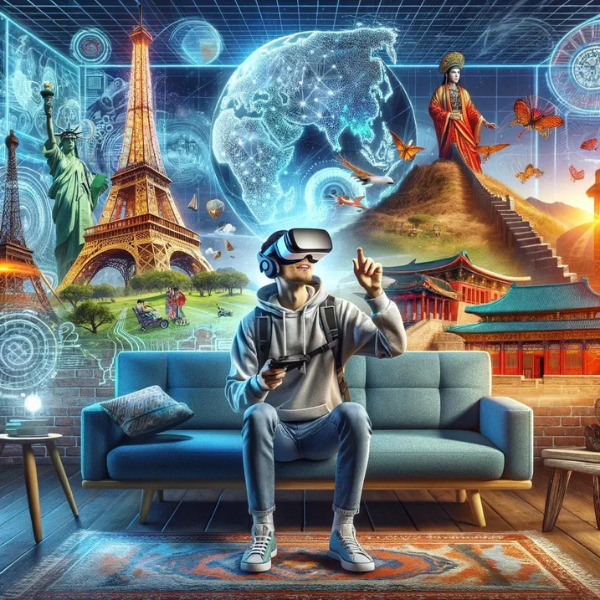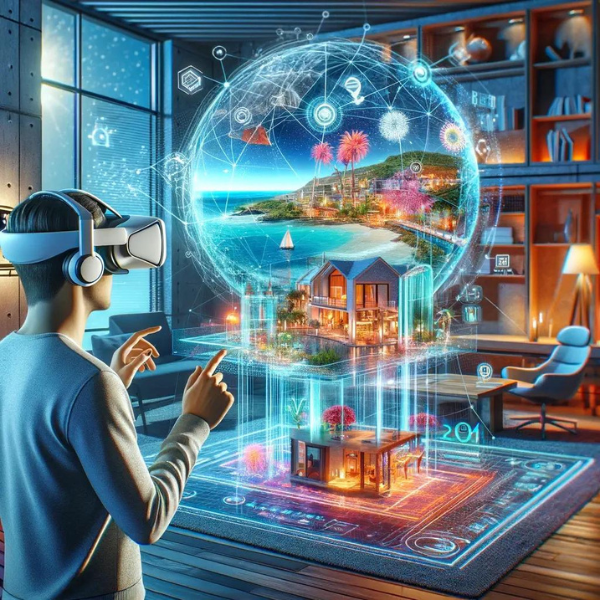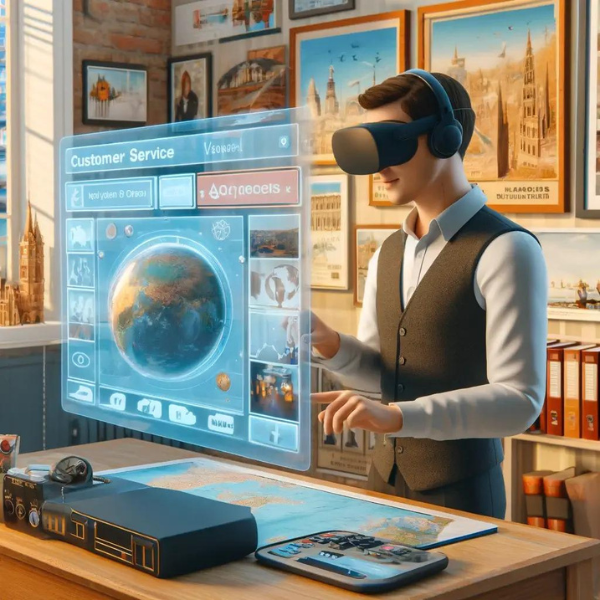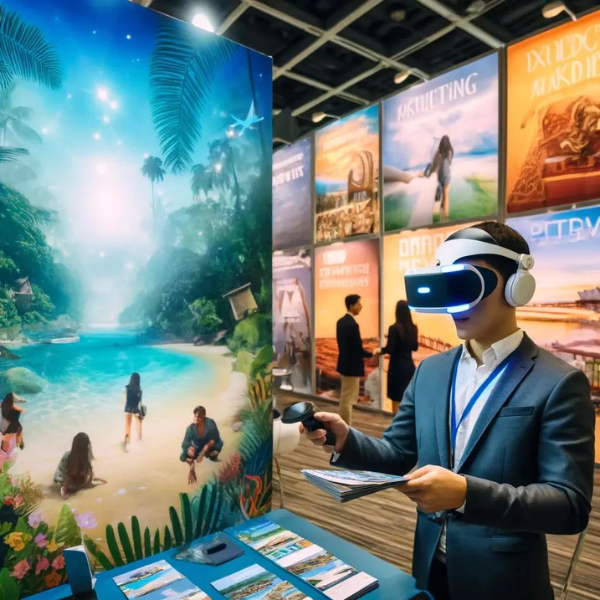Virtual reality in travel industry improves user experiences by immersing them in virtual places, lodgings, and activities. It is significant because it enables visitors to preview places, make educated decisions, and experience them remotely, resulting in better trip planning and more involvement with travel services and locations.
Thus, Virtual reality is revolutionizing the travel industry in exciting ways.
With VR technology, travelers can now explore destinations, hotels, and attractions from the comfort of their homes, making travel planning more interactive and informed. This article will delve into how VR is changing the travel landscape, offering new opportunities for both travelers and travel businesses.
Let’s dive into the fascinating world of Virtual reality in travel.
Why Virtual Reality is becoming Popular in Tourism Industry

The tourism industry is about to change significantly because of virtual reality. Rapid growth in VR use has been spurred by advancements in technology that enhance usability and appeal. High-quality VR headsets and affordable options like Google Cardboard have made it easier for tourists to immerse themselves fully in the places they visit. Similarly, if you are interested in augmented reality app cost, exploring the integration of AR with VR could offer more interactive and enriched experiences for tourists, potentially revolutionizing how we explore new destinations.
Virtual reality (VR) is being used more and more by travel companies to give possible customers a taste of what they can expect. This interactive technology helps bridge the gap between looking at travel websites and actually going to a place, making planning a trip more fun.
Role of Virtual Reality in Travel Industry
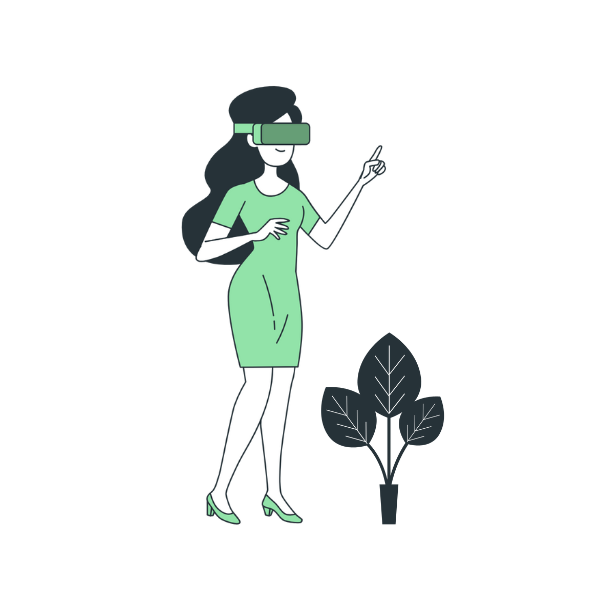
Virtual reality (VR) technology is approaching and is ready to change the way tourists travel. The possibilities are endless: it could improve travel experiences, change the way you sell your business, support environmentally friendly travel, and work well with augmented reality and AI.
With a VR headset or mobile device, users can virtually explore a destination, a hotel room, or even the historic sites or a cultural heritage site, all from the comfort of their own home. This technological gem isn’t just about helping travelers make well-informed decisions or planning their trips efficiently, it’s also an eco-friendly step towards reducing the harmful impacts of over-tourism.
Here is how VR is making a name for itself:
Immersive Travel Experiences with VR Technology
Virtual reality is making it possible to have immersive travel experiences from the comfort of your home. Imagine taking a stroll through the streets of Paris, exploring the pyramids of Egypt, or walking along the Great Wall of China—all without leaving your living room. VR technology allows you to experience these destinations in a highly realistic and engaging way.
Virtual tours of destinations are becoming increasingly popular. Travel agencies and tourism boards are using VR to showcase destinations to potential travelers. You can put on a VR headset and take a virtual tour of a hotel, museum, or even an entire city. This helps you get a feel for the place and decide if it’s somewhere you’d like to visit in person.
Pre-travel experiences can also aid in decision-making. By virtually visiting landmarks and attractions, you can plan your itinerary more effectively. You can explore different areas and see what interests you the most before you even book your trip. This not only enhances your travel experience but also helps you make more informed choices.
Virtual reality is opening up new possibilities for travel enthusiasts, allowing you to explore the world in a whole new way, making travel more accessible and exciting than ever before. Similarly, augmented reality in retail is transforming the shopping experience by enabling customers to visualize products in their own space before making a purchase, enhancing customer engagement and satisfaction.
VR Technology Enhanced Travel Planning
Virtual reality is also transforming the way we plan our trips. Traditionally, travel planning involves reading guidebooks, browsing websites, and looking at photos. While these methods are helpful, they often don’t give you a complete picture of your destination. This is where VR comes in.
With VR, you can take an interactive tour of your destination before you go. Imagine exploring your hotel room, checking out the amenities, and walking around the neighborhood. You can see exactly what your accommodations look like, which helps in making more confident booking decisions.
Interactive travel guides are another innovative use of VR. These guides allow you to explore cities and attractions in a more dynamic way. Instead of just reading about a place, you can experience it virtually. For example, you can take a virtual tour of a city’s historic district, complete with detailed information about each landmark you encounter. This immersive experience makes travel planning more engaging and informative.
VR-based travel apps and platforms are becoming more popular, offering a range of tools to enhance your planning process. These apps provide virtual tours, interactive maps, and even virtual reality travel agencies where you can plan and book your entire trip. By using these tools, you can create a detailed and personalized travel itinerary that meets all your needs and preferences.
Virtual reality is making travel planning more comprehensive and enjoyable. It allows you to explore your destination in advance, ensuring that you have all the information you need to make the best choices for your trip.
How VR Technology Improved Customer Service?
Virtual reality is also revolutionizing customer service in the travel industry. It’s enhancing the way travelers receive support and making the entire travel experience smoother and more enjoyable.
One significant application of VR in customer service is in customer support. Imagine having a virtual assistant who can guide you through booking processes, answer your questions, and help resolve any issues—all in a virtual environment. This level of interaction can make the process more intuitive and less stressful for travelers.
Additionally, VR is being used to train travel industry staff. Airlines, hotels, and travel agencies are adopting VR training programs to provide their employees with realistic scenarios and environments. For example, airline staff can practice emergency procedures in a virtual cabin, or hotel staff can learn how to handle various customer service situations in a virtual lobby. This hands-on training ensures that staff are better prepared to assist travelers effectively.
Virtual assistance in booking and inquiries is another innovative use of VR. Travelers can enter a virtual travel agency, interact with a virtual agent, and get all the help they need to plan their trip. This not only makes the booking process more interactive but also more personalized. It’s like having a travel agent available 24/7, ready to assist you with any aspect of your journey.
VR is improving customer service in the travel industry by making support more accessible, training more effective, and interactions more personalized. This ensures that travelers have a seamless and enjoyable experience from start to finish.
Marketing and Promotions With VR In Travel Industry
Technology is taking marketing and promotions in the travel industry to a whole new level. It’s helping travel companies create more engaging and immersive marketing campaigns that capture the attention of potential travelers.
One of the most exciting uses of VR in marketing is the creation of virtual reality advertisements. These ads allow travelers to experience a destination before they decide to visit. For example, a VR ad might take you on a virtual tour of a tropical beach resort, showcasing the crystal-clear waters, luxurious accommodations, and exciting activities available. This immersive experience can be far more persuasive than traditional ads, as it gives travelers a real sense of what to expect.
Travel agencies and tourism boards are also using VR to create immersive promotional content. They are developing virtual tours and experiences that potential travelers can access online. These virtual experiences can include walking tours of famous landmarks, adventures through natural parks, or explorations of cultural sites. By providing these interactive experiences, travel companies can inspire wanderlust and attract more visitors.
Moreover, VR is being used in trade shows and travel exhibitions. Travel companies set up VR stations where attendees can put on a headset and explore various destinations in virtual reality. This allows them to stand out from the competition and leave a lasting impression on potential customers.
Virtual reality is revolutionizing marketing and promotions in the travel industry by creating more interactive and memorable experiences. It helps travel companies showcase their destinations in a way that traditional marketing methods simply can’t match, ultimately driving more interest and bookings.
Accessibility and Inclusivity with VR

Virtual reality is making travel more accessible and inclusive for everyone, including those who face physical limitations or disabilities. This technology is opening up the world to people who may have thought travel was out of reach.
For travelers with disabilities, VR offers a way to experience destinations that might otherwise be challenging to visit. Virtual tours can provide a sense of exploration and adventure without the need for physical travel. For instance, someone who uses a wheelchair can virtually explore the narrow streets of a historic town or hike through a national park, experiencing the sights and sounds as if they were there.
VR also allows for the creation of inclusive travel experiences. Travel companies can design virtual experiences tailored to the needs of different users, ensuring that everyone can enjoy the journey. These experiences can include audio descriptions for visually impaired users or interactive guides that provide information in sign language for those who are deaf or hard of hearing.
Moreover, virtual travel can be a valuable resource for those unable to travel physically due to health issues or other constraints. It offers a way to satisfy wanderlust and learn about new cultures and places without leaving home. For example, virtual museum tours can provide an educational and enriching experience for individuals who can’t visit in person.
Virtual reality is breaking down barriers and making travel more inclusive. It allows everyone to experience the joy and excitement of discovering new places, regardless of their physical abilities or limitations.
Top 5 Real-World Examples of VR in the Travel Industry
Virtual reality is already making waves in the travel industry with several real-world applications. Let’s look at some examples of how VR is being used to enhance travel experiences:
1) Thomas Cook’s “Try Before You Fly” Campaign
Thomas Cook launched a VR initiative called “Try Before You Fly,” which allowed potential travelers to experience destinations like New York, Singapore, and Egypt through VR headsets available in select stores. This initiative reportedly increased bookings by 190% for New York holidays.
2) Marriott Hotels’ VR Postcards
Marriott Hotels introduced “VR Postcards,” a virtual reality experience that lets guests travel to different destinations through immersive 360-degree videos. This initiative provided a unique way for guests to explore global destinations from the comfort of their hotel rooms.
3) Ascape VR Travel App
The Ascape VR app offers virtual tours of various destinations around the world. Users can explore cities, landmarks, and natural wonders using their VR headsets or smartphones, providing a convenient way to plan trips and experience new places virtually.
4) Qantas VR App
Qantas, an Australian airline, launched the Qantas VR app, allowing users to take virtual tours of popular Australian destinations and attractions. This app offers an immersive way to explore Australia’s beauty, helping travelers plan their trips.
5) Expedia’s Virtual Reality Tours
Expedia has incorporated VR tours into its platform, allowing travelers to take a virtual walk through hotels and resorts before booking. This feature helps travelers make more informed decisions by giving them a realistic preview of their accommodations.
These examples tell us how VR is already being used to transform the travel industry, providing innovative solutions for travelers and enhancing the overall travel experience.
Final Words
Virtual reality is transforming the travel industry in remarkable ways. It offers immersive travel experiences that let you explore destinations from the comfort of your home. VR enhances travel planning by providing interactive guides and virtual tours that help you make informed decisions. Customer service is improved through VR training and virtual assistance, making the travel process smoother and more personalized.
In marketing and promotions, VR creates engaging and memorable campaigns that showcase destinations like never before. Finally, VR makes travel more accessible and inclusive, allowing everyone to enjoy the wonders of the world, regardless of physical limitations.
As VR technology continues to advance, its impact on the travel industry will only grow, making travel more exciting, efficient, and accessible for all.
If you found this article helpful, you might also be interested in learning about “AR & VR Trends in E-commerce” to see how these technologies are shaping other industries as well.
Related User Queries
How can virtual reality help with travel safety?
Virtual reality can provide safety training for travelers, offering simulations of emergency scenarios and safety procedures, ensuring travelers are better prepared for their trips.
What are the costs associated with VR travel experiences?
The costs of VR travel experiences vary depending on the equipment and software used. Basic VR headsets can be affordable, while high-end devices and premium content may require a higher investment.
Can VR replace traditional travel experiences?
While VR provides an immersive and realistic experience, it cannot fully replace the sensory and emotional aspects of traditional travel. However, it serves as a valuable supplement and planning tool.
How do travel companies create VR content?
Travel companies often collaborate with VR content creators and developers to produce high-quality virtual tours and experiences. They use 360-degree cameras and advanced software to capture and create immersive environments.
What are the environmental benefits of VR travel?
VR travel can reduce the carbon footprint associated with traditional travel by allowing people to explore destinations virtually, potentially decreasing the demand for physical travel and its environmental impact.




